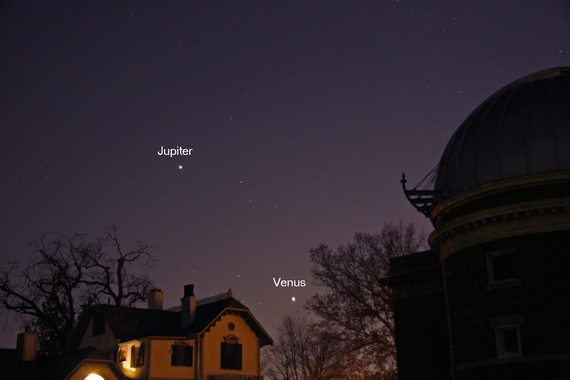At this time of year, people often ask for my astronomical/religious opinion: "What was the Star of Bethlehem?"
What was this heavenly sign that a savior, that a Messiah, that Jesus was born? Can modern science prove what this object really was?
Astronomers have been asked these questions for over a millennium. Many of my ancestors tried valiantly and faithfully to answer it with a supernova, a comet, or a variable star. Lately the most popular answer, thanks to sky simulation software that can show the skies of Bethlehem 2000 years ago, was that it was a planetary conjunction. All of them got it wrong.
The Gospel of Matthew
The Star of Bethlehem account appeared in only one of the four Gospels. The book of Matthew described the scene that heralded the beginning of Christianity. In the second chapter of his Gospel, Matthew wrote:
After Jesus was born in Bethlehem in Judea, during the time of King Herod, Magi from the east came to Jerusalem and asked, "Where is the one who has been born king of the Jews? We saw his star when it rose and have come to worship him."
Herod asked the Magi where this "King" was born and the Magi responded, "In Bethlehem." Matthew continued:
Then Herod called the Magi secretly and found out from them the exact time the star had appeared. He sent them to Bethlehem and said, "Go and search carefully for the child. As soon as you find him, report to me, so that I too may go and worship him."
After they had heard the king, they went on their way, and the star they had seen when it rose went ahead of them until it stopped over the place where the child was. When they saw the star, they were overjoyed.
Is there an object in space that could match the description given?
A Planetary Conjunction? Don't Be Insulting
The popular answer among astronomers, astrologers, and historians today is that the Star of Bethlehem was a planetary conjunction. Two bright planets appeared so close together in the sky that they merged into one giant, super-star. This happened once with Jupiter and Venus in 2 BC, but it was only visible in the western sky. Stars don't rise in the west. No other planetary conjunctions were close enough to overlap in that decade.
I also find this answer insulting to the ancient stargazers. They knew what Venus and Jupiter were. The close conjunction in 2 BC occurred for a few hours one evening; however the conjunction built up over days.
Photo by Steve Rismiller
For example, on a Monday night stargazers would note, "Hey there's Venus and Jupiter a few degrees apart." On Tuesday night, "There's Venus and Jupiter again and they're getting closer." And then on the night of the conjunction, would they be surprised and say, "Oh my God, look at that star! I wonder what it is. Let's follow it!" And then the next night they would return to their stargazing to note, "There's Venus and Jupiter again." Any learned observer of the sky would've known exactly what was happening. It would've been incredible to witness, but these were Wise Men, remember? They certainly wouldn't have been fooled.
The Heavens Never Stop
The major problem is that no astronomical object will stop in its motion across the sky. A meteor, comet, supernova, variable star or planetary conjunction all move. Three wise men could follow a "star" over the course of a night as it rises in the east, moves toward the south, and then sets in the west. But nothing in space would stop thanks to the Earth never ending rotation.
Unsolvable Mystery
I need more information. The chroniclers of the Bible did not record natural occurrences with the trained eye of modern scientists. They were approaching the heavenly motions from a different world view than we have today.
But what would actually work? To satisfy Matthew's account for the Star of Bethlehem we would need an object that:
- Is very distinct and noticeable;
- Doesn't move with the stars in a normal fashion;
- Was visible to the Magi during their travels and on the day when they found Jesus;
- Was not visible to Herod;
- Was not visible to any other sources;
- Was last seen only in the greater Bethlehem area.
There is really only one conclusion: The Star of Bethlehem was a UFO.
Now I'm not saying that it was a flying saucer. I'm saying that no natural object behaves in a way that the Bible describes. It matches no known object. It has no equal. It is an unidentifiable flying object.
And I think this is how it should be. Why would you want the birth of Jesus to be marked by something that happens occasionally like a comet or planetary conjunction? Having it be the time Jupiter and Venus came together is offensive. Shouldn't His birth be marked by something that has only happened once and never repeated? Shouldn't this momentous occasion in the birth of a religion have something truly other-worldly for a sign? It should be mysterious. It should be unexplainable.
The Star of Bethlehem reminds me of that famous line, "The Bible tells us how to go to heaven, not how the heavens go."
Merry Christmas, and keep looking up!

